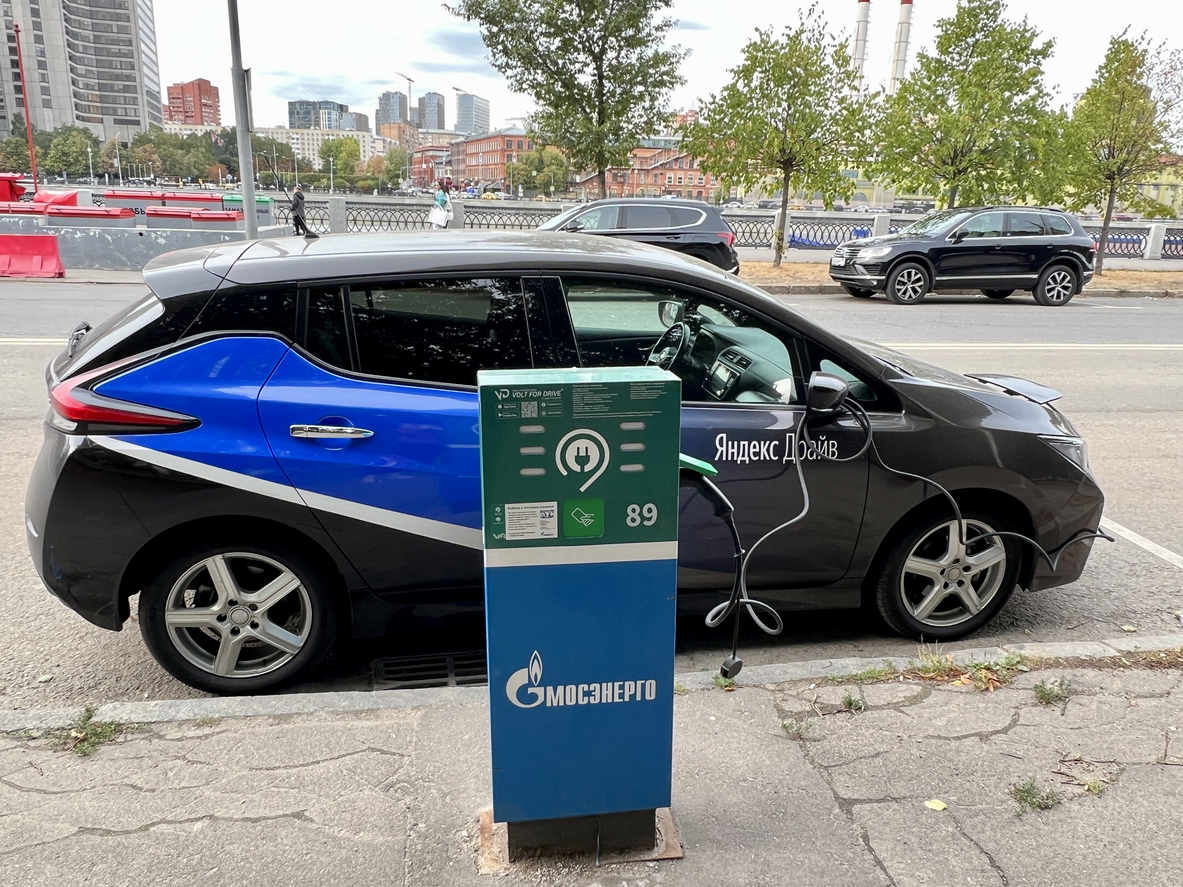HSE Experts Highlight Factors Influencing EV Market Growth

According to estimates from HSE University, Moscow leads in the number of charging stations for electric vehicles in Russia, while Nizhny Novgorod ranks first in terms of charging station coverage, with 11.23 electric vehicles per charging station, compared to 14.41 in Moscow. The lack of charging infrastructure is one of the key factors limiting the growth of the electric vehicle market. This is stated in the study titled ‘Socio-Economic Aspects of Introducing Electric Vehicles in Commercial Transportation’ conducted by experts from the Institute of Transport Economics and Transport Policy Studies at HSE University.
The use of electric vehicles (EVs) significantly reduces fuel and maintenance costs, while also offering incentives for owners, making electric transport economically viable. The main challenges holding back the growth in the number of EVs include limited driving range, rapid battery degradation, substantial initial investments, and rising operating costs. According to experts at HSE University, further promotion of EV use requires support measures such as localising production, offering incentives for purchasing EVs, increasing the number of charging stations, and implementing flexible electricity tariffs.
By the end of 2024, 59,600 electric vehicles were registered in Russia, marking a 225% increase in their number since 2015. According to experts, the growth in electric car sales in Russia in 2024 was primarily driven by Chinese manufacturers and the Moskvich Moscow Automobile Plant.

At the same time, imports of new and used electric vehicles declined by 34% and 22%, respectively, between 2022 and 2023, while large-scale localisation of new models remains constrained by strict regulations.
Experts at HSE University warn that a further reduction in government support and tighter import restrictions could slow the growth of the EV market.
Infrastructure and Regional Factors
According to experts, expanding the charging infrastructure network remains a major factor in the widespread adoption of electric vehicles. Currently, Moscow has the largest number of charging stations in the country, but Nizhny Novgorod ranks first in terms of charging stations relative to the number of electric vehicles. By 2030, the number of stations in Moscow is expected to reach 12,000, with the electric vehicle fleet growing to 300,000.
At the same time, electric vehicles remain a practical mode of transport mainly for large cities and metropolitan areas that actively support their adoption and invest in expanding the infrastructure network. According to estimates, the total cost of owning an electric vehicle may be lower than that of a conventional one, but in practice, much depends on operating conditions, battery degradation rates, and the availability and scope of government support—for example, the costs of adopting electric vehicles remain significant for commercial companies.

Director, Centre for Transportation Planning, Institute for Transport Economics and Transport Policy Studies
'According to current national policy documents, within ten years, the EU, the UK, Israel, and 25% of US states are expected to ensure that 100% of vehicle sales are zero-emission, while Japan and Singapore aim to achieve 100% electric vehicle sales. However, rapid growth in this segment driven solely by battery electric vehicles (BEVs) may face an alternative path: in countries where internal combustion vehicles remain widespread, the transition is likely to occur through increased adoption of hybrid vehicles, which are classified as EVs based on certain operating parameters but still retain the ability to use fossil fuels.'
See also:
Larger Groups of Students Use AI More Effectively in Learning
Researchers at the Institute of Education and the Faculty of Economic Sciences at HSE University have studied what factors determine the success of student group projects when they are completed with the help of artificial intelligence (AI). Their findings suggest that, in addition to the knowledge level of the team members, the size of the group also plays a significant role—the larger it is, the more efficient the process becomes. The study was published in Innovations in Education and Teaching International.
New Models for Studying Diseases: From Petri Dishes to Organs-on-a-Chip
Biologists from HSE University, in collaboration with researchers from the Kulakov National Medical Research Centre for Obstetrics, Gynecology, and Perinatology, have used advanced microfluidic technologies to study preeclampsia—one of the most dangerous pregnancy complications, posing serious risks to the life and health of both mother and child. In a paper published in BioChip Journal, the researchers review modern cellular models—including advanced placenta-on-a-chip technologies—that offer deeper insights into the mechanisms of the disorder and support the development of effective treatments.
Using Two Cryptocurrencies Enhances Volatility Forecasting
Researchers from the HSE Faculty of Economic Sciences have found that Bitcoin price volatility can be effectively predicted using Ethereum, the second-most popular cryptocurrency. Incorporating Ethereum into a predictive model reduces the forecast error to 23%, outperforming neural networks and other complex algorithms. The article has been published in Applied Econometrics.
Administrative Staff Are Crucial to University Efficiency—But Only in Teaching-Oriented Institutions
An international team of researchers, including scholars from HSE University, has analysed how the number of non-academic staff affects a university’s performance. The study found that the outcome depends on the institution’s profile: in research universities, the share of administrative and support staff has no effect on efficiency, whereas in teaching-oriented universities, there is a positive correlation. The findings have been published in Applied Economics.
Physicists at HSE University Reveal How Vortices Behave in Two-Dimensional Turbulence
Researchers from the Landau Institute for Theoretical Physics of the Russian Academy of Sciences and the HSE University's Faculty of Physics have discovered how external forces affect the behaviour of turbulent flows. The scientists showed that even a small external torque can stabilise the system and extend the lifetime of large vortices. These findings may improve the accuracy of models of atmospheric and oceanic circulation. The paper has been published in Physics of Fluids.
Solvent Instead of Toxic Reagents: Chemists Develop Environmentally Friendly Method for Synthesising Aniline Derivatives
An international team of researchers, including chemists from HSE University and the A.N. Nesmeyanov Institute of Organoelement Compounds of the Russian Academy of Sciences (INEOS RAS), has developed a new method for synthesising aniline derivatives—compounds widely used in the production of medicines, dyes, and electronic materials. Instead of relying on toxic and expensive reagents, they proposed using tetrahydrofuran, which can be derived from renewable raw materials. The reaction was carried out in the presence of readily available cobalt salts and syngas. This approach reduces hazardous waste and simplifies the production process, making it more environmentally friendly. The study has been published in ChemSusChem.
How Colour Affects Pricing: Why Art Collectors Pay More for Blue
Economists from HSE University, St Petersburg State University, and the University of Florida have found which colours in abstract paintings increase their market value. An analysis of thousands of canvases sold at auctions revealed that buyers place a higher value on blue and favour bright, saturated palettes, while showing less appreciation for traditional colour schemes. The article has been published in Information Systems Frontiers.
New Method for Describing Graphene Simplifies Analysis of Nanomaterials
An international team, including scientists from HSE University, has proposed a new mathematical method to analyse the structure of graphene. The scientists demonstrated that the characteristics of a graphene lattice can be represented using a three-step random walk model of a particle. This approach allows the lattice to be described more quickly and without cumbersome calculations. The study has been published in Journal of Physics A: Mathematical and Theoretical.
Scientists Have Modelled Supercapacitor Operation at Molecular and Ionic Level
HSE scientists used supercomputer simulations to study the behaviour of ions and water molecules inside the nanopores of a supercapacitor. The results showed that even a very small amount of water alters the charge distribution inside the nanopores and influences the device’s energy storage capacity. This approach makes it possible to predict how supercapacitors behave under different electrolyte compositions and humidity conditions. The paper has been published in Electrochimica Acta. The study was supported by a grant from the Russian Science Foundation (RSF).
Designing an Accurate Reading Skills Test: Why Parallel Texts are Important in Dyslexia Diagnosis
Researchers from the HSE Centre for Language and Brain have developed a tool for accurately assessing reading skills in adults with reading impairments. It can be used, for instance, before and after sessions with a language therapist. The tool includes two texts that differ in content but are equal in complexity: participants were observed to read them at the same speed, make a similar number of errors, and understand the content to the same degree. Such parallel texts will enable more accurate diagnosis of dyslexia and better monitoring of the effectiveness of interventions aimed at addressing it. The paper has been published in Educational Studies.


